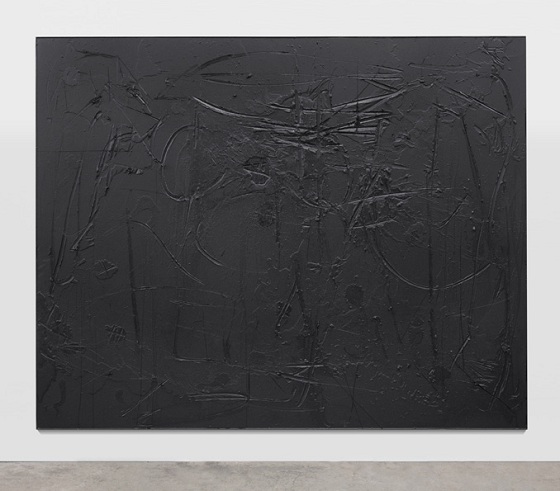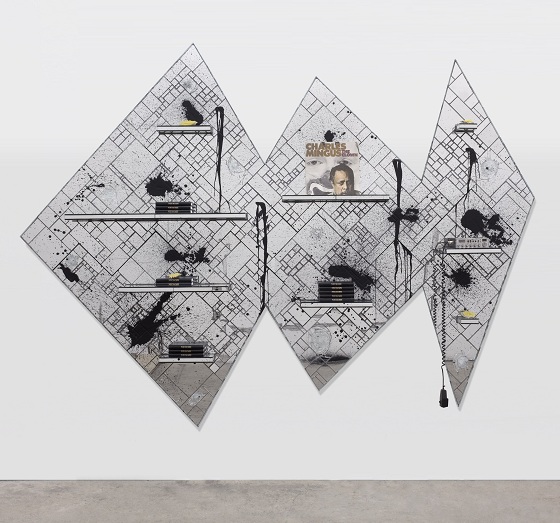Midway through Roberta Smith’s recent review of Damien Hirst’s Complete Spot Paintings, she asked: “Am I grading on a curve?” It’s a good question, and one that recognizes the difficulty of measuring art on a shifting scale: a good show at one gallery is a disappointment at another, and the best show in January might have been middling in the bustle of October.
Make no mistake: Rashid Johnson’s Rumble is one of the best shows in New York right now. It’s a tightly interwoven, confidently executed show that looks good, sounds smart, and plays to the preternatural ability to move between media that is Johnson’s greatest strength. At the same time, it has obvious flaws: it is unmoving, at times indecipherable, and falls into the Conceptualist trap of sounding better as a press release than it looks as a show.
The press release, though, is a doozy. Johnson, we’re told, is interested in the boxing promoter Don King, and particularly in his symbolic role in the mid-1970s to a black consciousness torn between neo-African black nationalism and King’s “gleeful American boosterism”. In Johnson’s words, “One moment everyone was wearing dashikis and looking for their African roots. Suddenly that all stopped and they were listening to hip-hop and watching shows on the Black Entertainment Network.” It’s a fascinating starting point, but turns out to be a red herring: other than the occasional boxing-related title (Rabbit Punch, The Sweet Science), nothing here taps into the interest and power of that moment.
The visual stars of the show are two large gestural black paintings, Black Orpheus and The Berlin Conference, created by pouring a hot mixture of wax and black soap (a substance made from the ash of West African plants) into a 2-inch-deep frame and clawing grooves into the material with a palette knife as it cools. It’s a technique that offers a lot of room for expression, particularly because of the rapid cooling of the wax; marks must be made quick and bold to have depth, and as a result the finished works act as archaeological specimens, telling the story of their making, stroke-by-stroke.
The two works exhibit different approaches to this process: Black Orpheus works with the medium, using broad, expressionistic gestures, while The Berlin Conference struggles against it, attempting to lay out a rough grid of regular depth despite the cooling material. It's tempting, if groanworthy, to link them to their titles: the title of the looser work refers to the 1959 Marcel Camus film set during Rio's Carnival, while the gridlike piece refers to the 1884 meeting at which European delegates divided Africa into spheres of European influence. On their own, the two works aren’t earth-shattering, but they’re beautiful and significantly more evocative than Johnson’s previous works in the same Cosmic Slop series, which were poured, rather than sculpted, and significantly smaller.
A series of four works on mirrored tile – a relatively new medium for the artist – are far weaker. Two large, rectangular pieces are splattered with strategically-placed splashes of the black soap-wax-paint mixture; the splashes do little, and the mirrors – a usefully weighted medium – do less. Another pair, more irregularly shaped, bear shelves holding Johnson’s characteristic objects of mysterious blackness: jazz albums by Charles Mingus and Ahmad Jamal; books with titles like “Negrosis” and “Rumble [in the Jungle]”; and oyster shells filled with shea butter. The latter is a nod to Zora Neale Hurston’s announcement in “How It Feels to Be Colored Me”: “I am not tragically colored. There is no great sorrow dammed up in my soul, nor lurking behind my eyes. … No, I do not weep at the world–I am too busy sharpening my oyster knife.”
There are three issues with this latter pair. Firstly, the mirrors are simply redundant: mirrors serve to make one aware of themselves, their appearance, and their identity, but raising the issue of race at all accomplishes that handily on its own. Second, the varying shapes of the mirrors do nothing for the works; they are unnecessary, unpleasant, lifeless jags with no apparent relationship to the objects, space, or other works in the show. Third, the uneven shelves, distracting reflections and splatters, and obvious binding concept deny the pieces the mysterious aura that shelf art normally relies upon; the whole practice is based around the fun of trying to fit seemingly incongruous objects together, and encouraging an air of mystery requires a certain deadpan to the presentation of the objects. Here, there’s little encouragement to do any mental work, as a viewer, once one has acknowledged that these objects have some importance to Johnson; we are confused witnesses to the artist’s discoveries, but discouraged from exploration ourselves.
Two floors, made of red oak boards branded with a collection of symbols, do a better job. One, Squaring the Circle, holds a fairly reserved collection of signs, each a respectable distance from the others – the sign of the Boulé, an elite black fraternity, appears, along with the crosshairs and palm trees that appear in much of Johnson’s work. A room away, the other floor is a frantic mess of wrecked imagery; in it, half-circles and empty shapes collide and explode, with the relatively undisturbed Boulé symbol in the center looking a bit like a traumatized survivor. The piece is mounted on the wall, a move that might veer dangerously close to the condescending (we understand you want us to pay attention to the floor, thank you very much) were it not for two large pours of black paint that reveal it must have been made upright, too. That's a great gesture, because it draws attention to the work's making: the symbols themselves might hold no particular interest, but there's power in the gesture of Johnson, as a black artist, using a brand to display a personal collection of images. Tying your work to process is a great way to make your identity interesting to someone other than yourself.
Ultimately, that issue of universality is present in the entire show. The CB radios in a few of the pieces are a good example; they're supposedly a reference to the artist's father, who built and repaired radios in the 1970s, but they don't do much for the viewer. Let's be frank: the great imagery of our time will not involve Rashid Johnson's dad.
It's unclear whether Johnson understands the degree to which this can be an issue. Time and again in Rumble, an element will click together neatly in one work, only to reappear as a flaw in another. In Black Yoga Communication Station, for instance, there's a radio, but it's integrated into a piece of furniture such that it looks like it might still work; that lets me think about communication, and the colorblindness of radio, the 1970s, why this mysterious “Black Yoga” might need to communicate, and so on. It works, because it deals with associations I already have with the radio, and because the secret biographical history is informative but not integral. In one of the mirrored tile works, though, an identical radio placed on a shelf looks arbitrary in the extreme: why is this object of personal significance suddenly being shown on a shelf? It's a form of display that highlights formal characteristics, but the formal characteristics of a CB radio don't seem to have much to do with anything; as a result, we're left to assume it's something mysterious and personal, and we leave it at that.
Johnson may well have succeeded at translating his identity into form, but he's done little to give the viewer the vocabulary to understand, and that's a serious problem. I hear Johnson – the force and timbre of his expression, in the wax trenches of the Cosmic Slop series or the branding of the floors – and I'm impressed, but there's nothing I can do to actually listen. The result is a show that doesn't say much at all.




Comments on this entry are closed.